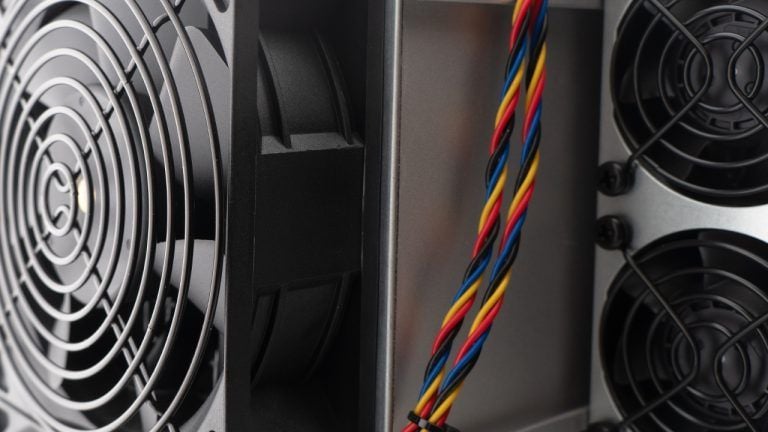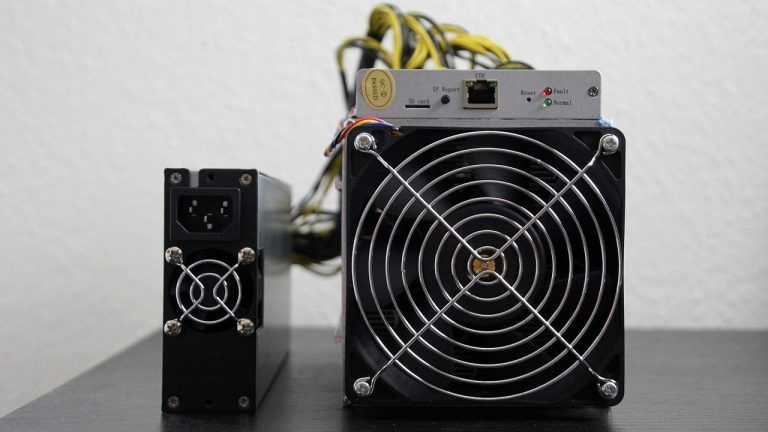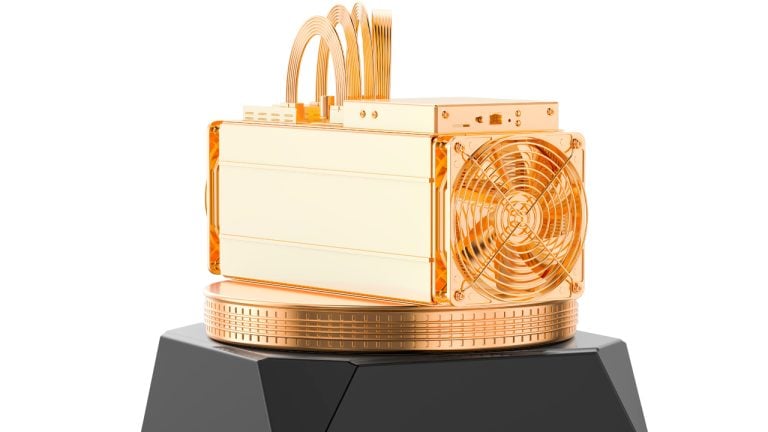 The U.S. Customs and Border Protection Agency has halted imports of certain Antminer ASICs produced by Bitmain. Bitmain Rivals Spared The U.S. Customs and Border Protection Agency (CBP) has reportedly been blocking imports of Bitmain made Antminer ASICs. The border agency, which has not provided reasons for the blockade, is believed to be acting on […]
The U.S. Customs and Border Protection Agency has halted imports of certain Antminer ASICs produced by Bitmain. Bitmain Rivals Spared The U.S. Customs and Border Protection Agency (CBP) has reportedly been blocking imports of Bitmain made Antminer ASICs. The border agency, which has not provided reasons for the blockade, is believed to be acting on […] This week, Bitmain introduced its latest bitcoin mining machine, which packs an impressive punch with a reported output of 860 terahash per second (TH/s). To put that in perspective, this new rig churns out 81.81% more hashpower than its predecessor, the Antminer S21 XP Hydro. And if we go way back, it’s a mind-blowing 477,677% […]
This week, Bitmain introduced its latest bitcoin mining machine, which packs an impressive punch with a reported output of 860 terahash per second (TH/s). To put that in perspective, this new rig churns out 81.81% more hashpower than its predecessor, the Antminer S21 XP Hydro. And if we go way back, it’s a mind-blowing 477,677% […] During the first week of August 2024, Bitcoin’s hashprice—a key metric that gauges the daily value of one petahash per second (PH/s) of hashpower—dipped to its lowest point in history, sliding below $38 per PH/s. In this fiercely competitive bitcoin mining arena, only the most resilient operations can thrive, with the best-performing machines bringing in […]
During the first week of August 2024, Bitcoin’s hashprice—a key metric that gauges the daily value of one petahash per second (PH/s) of hashpower—dipped to its lowest point in history, sliding below $38 per PH/s. In this fiercely competitive bitcoin mining arena, only the most resilient operations can thrive, with the best-performing machines bringing in […] According to statistics from mid-May 2023, 18 different application-specific integrated circuit (ASIC) bitcoin mining devices are profitable using today’s bitcoin exchange rates. Additionally, the top bitcoin mining machines today are made by three prominent ASIC manufacturers, as fabrication competition these days is limited.
18 ASICs Profit With Electricity Costs at $0.12 per kWh and Today’s […]
According to statistics from mid-May 2023, 18 different application-specific integrated circuit (ASIC) bitcoin mining devices are profitable using today’s bitcoin exchange rates. Additionally, the top bitcoin mining machines today are made by three prominent ASIC manufacturers, as fabrication competition these days is limited.
18 ASICs Profit With Electricity Costs at $0.12 per kWh and Today’s […]
With a new quarterly production record, Marathon Digital is now on track to meet its mid-year target of 23 exahashes.
Bitcoin (BTC) mining firm Marathon Digital has reported a quarterly record of 2,195 BTC mined over the first quarter of 2023, currently worth around $62 million.
Marathon reported in an April 3 update that the 2,195 mined BTC is a 74% increase from the first quarter of last year and a 41% increase from Q4 2022.
It comes on the back of the miner increasing its operational hash rate by 195% from Q1 2022.
Marathon also recorded a monthly record of 825 BTC mined in March — currently valued at around $23.3 million — and marked a 21% production increase from February.
$MARA's March Production Update is here:
— Marathon Digital Holdings (NASDAQ: MARA) (@MarathonDH) April 3, 2023
- Increased #Bitcoin Production 21% MoM
- Produced a Record 825 BTC in March ’23
- Produced a Record 2,195 BTC in Q1 ’23
- Increased Hash Rate 64% in Q1 ’23 (11.5 EH/s)
- Reported Unrestricted Cash and Cash Equiv. of $124.9M
- Increased… pic.twitter.com/Jc1ACI2kY2
In a statement, CEO Fred Thiel said Marathon made “notable progress” on executing its two primary initiatives for 2023 — to energize its previously purchased mining rigs to reach 23 exahashes by the end of the second quarter and to optimize performance.
The firm is now exactly on target, having increased its operational hash rate from 7.0 exahashes on Jan. 1 to 11.5 exahashes as of March 31.
Marathon’s management attributed the increase in efficiency to it bringing online 25,900 Bitcoin miners based in various facilities in North Dakota, bringing its fleet to 105,200 mining rigs as of April 1.
Marathon explained its operational improvements cleaned up part of its balance sheet by wiping out $50 billion in debt in addition to repaying its loan back to the now-failed Silvergate Bank:
“We reduced our debt by $50 million and increased our unrestricted Bitcoin holdings by 3,132 Bitcoin after we prepaid our term loan and terminated our credit facilities with Silvergate Bank.”
The firm finished the quarter with approximately $124.9 million in unrestricted cash and cash equivalents, and 11,466 BTC, which equates to over $450 million.
Marathon noted the figures have not been audited.

Related: Bitcoin ASIC miner prices hovering at lows not seen in years
Marathon expects operational efficiencies to continue having purchased a new batch of Antminer S19 XPs Bitcoin mining rigs that are said to be nearly 30% more efficient than the Antminer S19 Pro.
Once those miners are installed approximately 66% of Marathon’s hash rate will come from the S19 XPs, it said.
The design of S19 XPs has, however, been criticized by fellow Bitcoin mining firm Compass Mining.
In a March report the firm identified “three flaws” of the new S19s which may result in the mining rig overheating, or in some cases, shutting down completely.
Magazine: Hodler’s Digest: FTX EU opens withdrawal, Elon Musk calls for AI halt, and Binance news

Mining a valid BTC block solo is so rare that the event has occurred only 270 times out of the 700,000 blocks produced in the last 13 years.
A solo Bitcoin miner has managed to mine the 780,112th block in the Bitcoin blockchain, receiving a 6.25 Bitcoin (BTC) block reward in return. The estimated value of the payout is over $150,000.
The solo miner was also lucky to have produced a valid hash after just two days of mining, as the event itself is rare, and it can take months for a solo miner to produce a valid hash.
The rare event occurred on March 10 and was the 270th solo mined block in Bitcoin’s 13-year-long history. The event is rare because a solo miner of this size usually solves a block, on average, about once every 10 months.
Congratulations to miner39nDQ9BexEBXpRdkHY1z95CaMDEwh6muPW who solved the 270th solo block at https://t.co/UWgBvLkDqc with 6.7PH but doesn't appear to have been mining for very long https://t.co/WGVBC3QajX
— Dr. Con Kolivas (@ckpooldev) March 10, 2023
The miner created a solo mining pool using the Solo CK Pool mining service, for which they produced a valid block hash and were rewarded with 6.25 BTC, with a fee reward of roughly 0.63 BTC.
Con Kolivas, the Solo CK mining pool admin, noted that the miner behind the rare event might have temporarily rented hashing power to produce the output hash.

Bitcoin mining requires miners to input computational power to solve and add the next Bitcoin block to the network. However, with the growing popularity of BTC mining and the constant rise in the network hash rate and powerful mining machines, it’s near impossible for a solo miner to solve the whole block on their own.
Related: How to mine Bitcoin: A beginners guide to mine BTC
Thus, a valid block hash is often produced using the computational power of multiple mining rigs, all trying to mine the next block. The block reward is distributed according to the input hash rate of each miner in the mining pool.
The Solo CK mining pool has been behind several solo-mined Bitcoin blocks in the past as well. Two of these solo-mined blocks came in January 2022, only two weeks apart, with the first occurring on Jan. 11, 2022, at a block height of 718,124, followed by another on Jan. 24, at a block height of 720,175.

The Bitcoin miner announced the purchase of 20,000 new Antminer S19j Pro+ at a 25% discount, approximately $13.25 per terahash.
Bitcoin miner CleanSpark is growing its mining capacity in the United States with the purchase of 20,000 new Antminer S19j Pro+ units for $43.6 million. The acquisition is expected to boost the company’s computing power by 37% and brings the total number of miners purchased during the bear market to 46,500 units.
According to a statement on Feb. 16, CleanSpark will pay $32.3 million for the machines after applying coupons at a 25% discount or a total price per terahash (TH) of approximately $13.25. The Pro+ rigs are 22% more productive than their previous models and are planned to be delivered in batches between March and May.
The company is leveraging the market’s lower rig prices to boost its mining capacity, while Bitcoin’s (BTC) price rebounds. According to data from Hashrate Index, the current price per TH of ASICs of the same Bitcoin mining efficiency are currently at $15.09, well below the $90.72 seen 12 months ago. CleanSpark said the Antminer S19j Pro+ model offers a better return on investment compared to the same ASIC-generation machines.
“After they are fully operational, they are expected to add 2.44 EH/s to CleanSpark’s existing 6.6 EH/s of bitcoin mining computing power (for a total of 9 EH/s), constituting a 37% increase,” noted the company.

CleanSpark claims that the acquired models continue to be more attractive to its operations in the current market conditions. “The S19j Pro+ delivers 122 terahash per machine and saves an average of 2 joules of energy per terahash compared to the S19j Pro model of the same generation.”
A total of 15,000 of the new machines will be delivered to the company’s locations in the city of Washington, Georgia. CleanSpark disclosed in January a $16-million expansion in the site, which is forecasted to increase its hash rate by 2.2 exahashes per second (EH/s), with its total hash rate reaching as high as 8.7 EH/s. The facility was acquired by the company in August last year before taking over Mawson Infrastructure Group’s facility in Sandersville.
Wow. $CLSK has purchased 20,000 Antminer S19j Pro+ units at a 25% discount, bringing the # of #bitcoin mining machines bought in the #bearmarket above 46,500.
— CleanSpark Inc. (@CleanSpark_Inc) February 16, 2023
This is expected to add 2.44 EH/s to our current #BTC #hashrate of 6.6 EH/s.
Full release: https://t.co/HfOd0UH4zK pic.twitter.com/tahKmfhi3j
After a tough year in 2022 with declining Bitcoin prices and high electricity costs, publicly listed mining companies saw a rise in mining production and hash rates in January, according to an analysis from Hashrate Index. CleanSpark boosted its Bitcoin mining production by 50% during the month, reaching a record monthly production of 697 BTC. Its hash rate rose to 6.6 EH/s from 6.2 EH/s in December.
Other public mining companies, such as Core Scientific, Riot, Marathon and Cipher have seen significant increases in Bitcoin production in the past month, helped by stable electricity prices and better weather conditions in the United States.

Dogecoin shifting to proof-of-stake would be good for the environment, but what impact would it have on miners and ASIC manufacturers?
There are rumors that Dogecoin could switch from proof-of-work to proof-of-stake (PoS).
Do I know if Dogecoin is switching to PoS?
No.
Do I think it’s going to PoS? Probably not.
But I love the “what if” game.
As a person who works in the crypto mining industry, I do my best to gauge where the market and mining industry are going, along with how that could play out. If Dogecoin makes a change to PoS or some other change to how new blocks are created, it would have massive ramifications for the mining industry.
Here’s a look at a few options and their effects.
I’m not going to debate whether or not Dogecoin will or should switch to PoS. While it’s hard to determine if the recent rumors about the potential for a switch are true or not, they were enough to have Bitmain supposedly pause Litecoin (LTC) and Dogecoin (DOGE) miner manufacturing.
The larger question in my mind is, What happens to miners if Dogecoin switches to PoS?
First, Scrypt mining would be devastated. DOGE accounts for over 60% of the revenue with Scrypt mining. Take it away, and every L3+, every LT6 and every Mini Doge Pro, literally almost every non-L7 miner not connected to $0.04-per-kilowatt-hour electricity would need to be unplugged immediately.
Network difficulty would likely bounce all over the place for some time, while miners with older equipment struggle with the decision to keep their ASICSs on or turn them off. The apex Scrypt miner, Bitmain’s Antminer L7, would see its profitability reduced by nearly 75%, reducing profits to a whopping $4.83/day at $0.05/kWh.
What about the miners that don’t have an industrial electric rate? At $0.10/kWh, the L7 9050M, which sold for around $9,000 a few weeks ago, would earn you $0.72/day.
Yikes!
A drastic change like this would result in those who had recently purchased an L7 being very unlikely to ever recover their investment, let alone generate any profits.
The vastly reduced profitability would inevitably lead to the price of the L7 dropping quicker than it did during the COVID-19-induced crypto crash. Pricing miners solely by their expected ROI time, at $5 a day profit, miners would be looking at the L7 having a price tag between $1,825 (12-month ROI) and $2,737.50 (18-month ROI). This reflects a minimum price reduction of nearly 70%.
How quickly would Bitmain react? Would they gradually reduce prices week after week similar to what Goldshell has done with many of its miners over the past few months? A strategy that repeatedly left a sour taste in the mouths of customers as they watched the price of the miner they just spent thousands of dollars on being slashed repeatedly.
Or would they come out and continue their recent trend of pricing miners fairly?
ASIC resellers would also bear the brunt of the negative consequences connected to a PoS shift by Dogecoin. Many L7 miners are suppliers, and retailers sitting on that would instantly need to be marked down by a substantial amount. However, based on their recent history of price-gouging customers, like charging $60,000 for a KD6 that is barely worth over $1,000 today, it’s doubtful many tears would be shed for them.
Many home miners would flood eBay and similar platforms with Scrypt miners. It would be a race to the bottom as desperate miners attempt to recoup whatever value is left in the hunk of metal that can now only be used as a doorstop or display piece if one is desperate.
Litecoin mining would survive. Those L7s would stay on because they’d still be somewhat profitable, and there really wouldn’t be another choice. It’s doubtful that the market would see a new Scrypt miner that could challenge the L7 to be developed anytime soon unless there already is a more efficient Scrypt miner in development. There are some rumors that Bitmain is working on a miner that would surpass the L7.
That’s a lot of disruption from the move to PoS, and we’ve only looked at one aspect of the crypto ecosystem. Numerous other questions and scenarios would need to be considered.
What would happen to network security?
Would the yield from staking cause DOGE to eventually be labeled a security?
Would Dogecoin be lauded for the change, or would the masses flee from what is now the second-largest PoW coin by market cap?
Now for my favorite what if. This option is unlikely, maybe even impossible, but there are different ways it could play out.
What if Dogecoin breaks away from merge-mining with LTC and creates its own mining algorithm?
Related: Dogecoin Foundation announces new fund for core developers
What if there’s a GPU mining renaissance? After the Ethereum Merge event, there’s a ton of really cheap GPUs available on the market. Those would get expensive really quickly. Mining purists would rejoice as they build their own mining rigs while trying to figure out how much DOGE they can stack. It really would be cool to see, but it wouldn’t last. The big three manufacturers — Bitmain, Goldshell and iBelink — would scramble to be the first to market with an ASIC miner.
Eventually, they’d each have at least one ASIC miner on the market, and naturally, they’ll get more powerful and more efficient over time. The jumps and increases in difficulty would be ridiculous, and just like with Bitcoin (BTC), it will eventually no longer be profitable to mine DOGE with GPUs. But it could also open the door to something the ASIC manufacturing market desperately needs: competition.
What if, following the short-lived GPU mining renaissance, a door opens for another manufacturer or manufacturers to enter the market? Currently, Bitmain, Goldshell and iBelink are the “big three,” and it’s really Bitmain that has a total stranglehold on the market. So, while it’s likely Bitmain would come out on top, what if there’s someone out there who can be first to market and maintain that lead and establish itself as a credible and reliable ASIC manufacturer?
What if that company decided to branch out into other miners and offer them fair prices? To be fair, we do have to commend Bitmain again for the pricing on its recent rollout of industry-altering miners. Reseller markups are still an issue, but that’s another topic. Perhaps this “new” competitor would adhere to the mantra that customer service actually matters. If customers could get over the reliability concerns and the company built a good product, that could happen. Admittedly, that’s a lot of what-ifs.
Alternatively, there’s a money-grab scenario for Dogecoin. The project could go directly to Bitmain, Goldshell and iBelink and say, “We’re creating our own mining algorithm, and we’ll give it to you and you alone. How much money will you give us?”
What would Goldshell pay to bring life back to a company that has taken a series of body blows from the recent altcoin miners released by Bitmain? Or would iBelink go all out to win the rights to make the miner? IBelink just released a new BM-K3 Kadena miner that boasts 70 terahashes — a nearly 75% increase over the next closest model — and it can’t celebrate because Bitmain is about to trump that with the new KA3 that brings 166 THs. In the case of a Dogecoin offer to ASIC manufacturers, how much would Bitmain pay to maintain its market dominance?
What if DOGE chooses to simply continue with Scrypt mining?
The status quo is not that exciting, but it seems to be the most likely outcome. Sure, there may be some changes that will pass a vote, but Dogecoin will most likely continue to be merge-mined with LTC on the Scrypt algorithm.
Bitmain is likely to continue pushing out L7 inventory before launching a more efficient Scrypt miner later this year AND Goldshell will launch a Mini Doge Pro 2 for home miners that will essentially be two Mini Doge Pros in one box. The upcoming LTC halving, along with the more efficient miners, will probably push several older models to shut down for good.
Crypto markets will go up, and crypto markets will go down. There will likely be some other crypto scandal that no one sees coming that will look incredibly obvious in hindsight. The sun will come up, and the sun will come down. Of course, most suppliers and especially resellers will continue to markup miners and squeeze everything they can out of regular customers.
It’s impossible to know what’s going to happen with Dogecoin in the future, but crypto is one of the few industries where anything can happen on any given day.
Regardless of whether Dogecoin switches to PoS, the crypto mining landscape has always changed rapidly, and Scrypt mining is no different.
Change is coming.
The views, thoughts and opinions expressed here are the authors’ alone and do not necessarily reflect or represent the views and opinions of Cointelegraph.
This article does not contain investment advice or recommendations. Every investment and trading move involves risk, and readers should conduct their own research when making a decision.
 Bitcoin miners have had a challenging year as the network’s mining difficulty reached an all-time high and the spot market price of bitcoin dropped below the cost of production. Currently, with electricity costs at $0.07 per kilowatt-hour (kWh), only 18 application-specific integrated circuit (ASIC) bitcoin mining rigs are able to turn a profit at current […]
Bitcoin miners have had a challenging year as the network’s mining difficulty reached an all-time high and the spot market price of bitcoin dropped below the cost of production. Currently, with electricity costs at $0.07 per kilowatt-hour (kWh), only 18 application-specific integrated circuit (ASIC) bitcoin mining rigs are able to turn a profit at current […]
The total Bitcoin mining revenue — block rewards and transaction fees — in U.S. dollars fell down to $11.67 million, a number last seen on Nov. 2, 2020, when Bitcoin’s trading price was around $13,500.
The revenue earned by Bitcoin (BTC) miners fell to two-year lows owing to poor market performance and a heavier computational demand amid rising network difficulty. However, an ongoing downturn in the Bitcoin hash rate over the past month has allowed miners to recoup losses.
The total Bitcoin mining revenue — block rewards and transaction fees — in U.S. dollars fell down to $11.67 million, a number last seen on Nov. 2, 2020, when Bitcoin’s trading price was around $13,500.

While the current market price of around $16,500 suggests an obvious increase in mining revenue, factors including greater mining difficulty and rising energy prices contribute to lower income in dollar terms.
Adding to the above, the difficulty of mining a Bitcoin block has skyrocketed to an all-time high of almost 37 trillion — forcing Bitcoin miners to spend more energy and computational power to stay competitive.

However, over the past three months, the hash rate of the Bitcoin network witnessed a steady decline. The hash rate stands at 225.9 exahash per second (EH/s), which fell 28.6% from its all-time of 316,7 EH/s on Oct. 31, 2022.
The hash rate is a security metric that helps protect the Bitcoin network from double-spending attacks. However, considering the grand scheme of things, temporary measures taken by the community include acquiring cheaper mining hardware and resettling in jurisdictions with low energy prices.
Related: Bitcoin miners look to software to help balance the Texas grid
New York City mayor Eric Adams believes that goal to make New York a crypto hub can be combined with statewide efforts to curb environmental costs related to crypto mining.
“I’m going to work with the legislators who are in support and those who have concerns, and I believe we are going to come to a great meeting place,” said Adams while revealing that the city will work with legislators to find a balance between the crypto industry development and legislative needs.